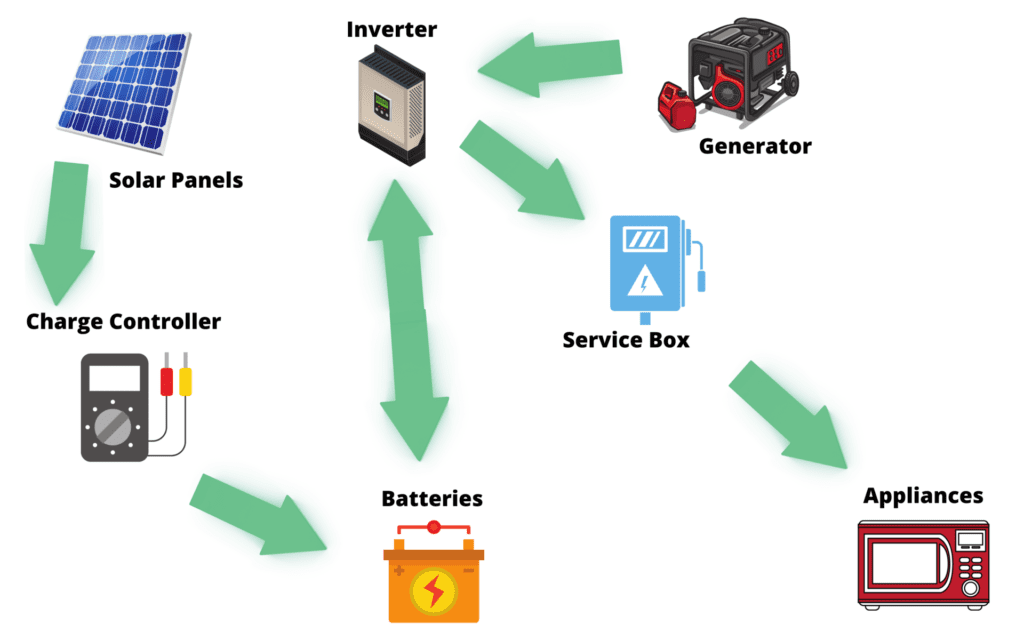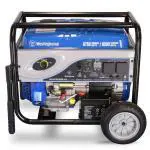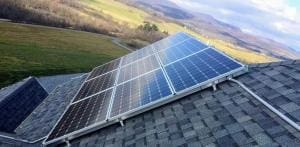Solar systems in Australia have become more popular over the last 10 years, mostly due to the price of renewable energy dropping materially. It comes to no surprise that some people start entertaining the notion of being fully autonomous and installing an off grid solar system in Australia. We explain what an off grid solar system is, how much they cost and more importantly if they’re worth it.
Before we assess an off grid solar system in Australia, let’s go through some of the basics just in case you’re not fully familiar with it:
The Basics of An Off Grid Solar System:
- Solar panels
- Charge Controller
- Battery bank
- Solar Inverter (AC)
- Generator (optional)
We won’t go into an in-depth explanation of how a conventional grid connected solar system works as we already have explained it
Here’s The Additional Components Required For An Off Grid Solar System
- Charge Controller: This component is necessary to regulate the current going to the batteries from the solar panels . They maintain batteries at a high state of charge without overcharging them. In a sense they ‘massage’ the charge of the batteries.
- Generator: This is for backup purposes just in case your batteries malfunction or there’s an overcast and your batteries are drained.
- Battery Bank: This is used to store the excess solar power that’s generated beyond the needs of your appliances. Be aware that once the batteries are fully recharged, the solar power is then throttled back to prevent the batteries from getting damaged.
Compare quotes from up to 7 installers in your area now.
There’s a Few Reasons Why Going Off The Grid Might Be Your Only Option
- You live in a rural area in Australia, typically remote parts of the outback where no electricity grid exists. Hence, you’re forced to build your own grid system.
- You’re already connected to the grid, but for some reason you experience blackouts frequently enough to force you to get off the grid.
- The nearest connection point to the grid from your home is far and the electricity network wants to charge you an excessive amount of money to connect you to it.
An Alternative to a Complete Off Grid Solar System
Hybrid Solar System:
This solar system can be thought of as a half-way point of still having access to the grid with the ability to also store excess solar energy within solar batteries.
The advantage of the hybrid solar system is that you get almost 100% uptime of electricity from the grid when required. By storing solar energy in your own batteries, you gain a certain level of autonomy by reducing your dependence on it by at least 70% to 95%.
The only major difference between a hybrid system and a grid-connected one is that it includes a battery inverter and batteries. If you’ve already got a regular grid connected solar system installed already, don’t fret because we’ve written an article about retrofitting battery storage to an existing solar PV system and what you should consider about it.
Hybrid solar systems are designed to prioritise solar first, battery second and grid power last. Hence, the batteries are relied upon to keep you going during the night or in theory if you suffer a grid outage. Just remember that in practice this may not always be so, because many hybrid systems don’t come with backup functionality out of the box. You will require additional specialised ‘switching equipment’ which enables you to go off the grid if a blackout occurs.
If you’re interested in going for a half-way option, we go into much more detail about hybrid solar systems. We also think you should be informed about the cost of batteries, which tends to be quite expensive relative to a solar PV system.
What Size Solar System Do You Need to Go Off The Grid?
The size requirements for your solar system are based mainly on the energy requirements of your home and the sunlight patterns in your area. We’ve outlined 3 examples below that should help steer you in the right direction but you will need an expert off-grid solar installer to help you get the optimal solution.
The examples below assume a NSW sunlight pattern and a north-facing roof space.
-
3kW of Solar With 8-10kWh Battery:
A 3kW Solar System with a 10kWh battery might be sufficient for a small energy user to go completely off-grid. Using a typical residential energy load profile and assuming an average of 10kWh of energy usage per day, we can see that this system would cover 95% of the annual energy requirements.
This means the household would need to run a generator or be without power for the rest of the time. Increasing the solar PV system size to 5kW would increase the coverage to 99%.
In terms of cost, on average a 3kW system will set you back about $4,700 using good quality components and a 10kWh battery will set you back at least $9,680 according to our latest battery price index. So you’re looking at about at around $15,000-$20,000 after including the generator and other off-grid components.
Overall Costs: $15,000 to $20,000
-
6kW of Solar With a 20kWh Battery:
With a bit more usage a larger solar and battery solution may still enable you to go off-grid. We’ve run the numbers on a household using 15kWh and 20 kWh a day on average. A 6kW Solar PV and 20kWh battery would cover 99% of the energy required for a house using 15kWh per day and 95% of a house using 20kWh per day.
This would increase to 100% and 98% if an extra 2kW of solar panels were installed (8kW) total. Any shortages of power could be covered by an generator, or the homeowner could wait until the sun rises the following day and for the batteries to start to charge again.
For a 6kW solar system your looking at about 14-16 panel requiring about 50m2 of roofspace and will set you back about $5,370 according to our latest solar panel Price Index. A 20kWh battery will add a fair bit more cost to the system and could require connected multiple batteries together in parallel. Based on our battery price index your looking at around $18,000 for a 20kWh battery. After adding all the components of an off-grid system the total cost is likely to be closer to $35,000
Overall Costs: $35,000 to $40,000
-
10kW of Solar With a 30kWh Battery:
This would be a very large system for a residential application, potentially suitable for someone looking for a bulletproof solution with very little need to ever run a generator, or an off-grid house hoping to use quite a lot of energy.
For a home with high energy requirements using 35kWh per day a 10kW solar PV and 30kWh battery solution would cover 92% of energy usage leaving the rest to run off a generator. Increasing the solar PV system size to 15kW would boost energy production through winter and increase coverage to 98%.
However, one important thing you should consider is cost. A 10kW solar PV system will typically cost between $10,000 and $15,000, while a 30kWh battery would cost around $25,000 based on current pricing. Assuming the power requirements are only single phase then the total cost for a 10kW solar and 30kWh off grid solution would like come to around $50,000.
Three phase requirements for off-grid solar system add a significant amount of cost to the project. It would probably be worth considering having a 3-phase generator if it would only be used for occasional use (like power tools).
Overall Costs: $45,000 to $55,000
If you’re still stuck and want to run some numbers for your specific situation, we’ve developed an off grid solar & battery storage sizing calculator to give you some concrete numbers which will help you make a more informed decision.
So, Is An Off Grid Solar System Worth It?
By now you’ve read how an off the grid system works, the common situations that people make, as well as the appropriate system size and resulting costs involved in making this decision.
But the ultimate overriding question that you will have by now is this: Is going off grid worth it?
There’s no simple answer and what we can tell you is that it really depends on your specific situation. As mentioned above, if you’re living in a remote part of Australia with no access to the grid, or your electricity provider wants to charge you an arm and a leg to connect to the grid because it’s far from you, then you really have no choice but to go fully off the grid. Hence, weather or not if it’s worth it is not a question to begin with. You simply have no choice if you want to enjoy a modern lifestyle
However, if your access to the grid is fragile with frequent blackouts and interruptions and this is causing you grief or stress, then we recommend you go for a hybrid solar system because the initial investment is cheaper than fully going off the grid. Also, you get the best of both worlds with reliable access to electricity from your provider with the added peace of mind that comes with a battery for those just-in-case moments. We go into more detail about hybrid solar systems as there’s a few nuances you should be aware of namely inverter types which may impact your decision.
Apart from that, it generally doesn’t make sense from an economical standpoint as your initial investment is at least two to three times higher because of the additional batteries and other pieces of equipment. You could make the argument that once the initial investment is paid off, then all future electricity usage will be free forever. However, the payback period will be considerably longer than a grid system, and so we recommend you run some calculations yourself.
Also, you will need to factor in other issues: An off grid solar system isn’t a set it and forget it thing to have. You will require a lot more maintenance than a grid based system, which means more ongoing costs. Due to technical limitations, you’ll occasionally run out of electricity. So, you’ll likely require the expertise of an off-grid solar specialist to design the system that best suits your situation, in order to minimise the risks of running out of electricity too often.
Since 2008 our knowledge and sophisticated software has allowed over 300,000 Australian households and businesses to make a well-informed choice on their solar & battery installer.
- Solar Panel Costs: Solar Choice Price Index | April 2025 - 1 April, 2025
- Solar Panels For Homes – All You Need to Know About Solar Systems - 18 March, 2025
- Best NSW Solar Feed-In Tariffs - 17 March, 2025






